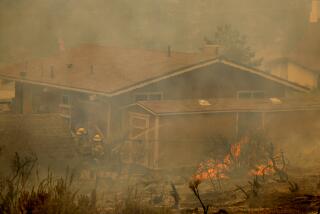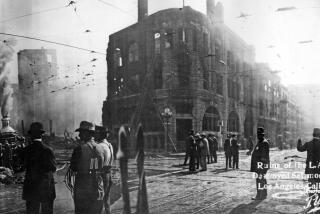From horror, a swelling tide of reform
The Triangle Shirtwaist Fire has, in American labor history, iconic status. The 146 people who either jumped to their deaths or burned inside the ninth-floor factory in Lower Manhattan at 5 in the afternoon on Saturday, March 25, 1911, became an incarnation of the courage born of despair that was required, at the turn of the 20th century, to raise a huge American underclass to the simple level of citizens of the republic.
That something momentous had occurred when the factory burned was immediately understood: “Four days [after the fire], some 350,000 people participated in a funeral march for the Triangle dead. [A] quarter of a million more lined the route and watched in silence. The whole city was muffled in black: black bunting on hundreds of buildings; multitudes in black dresses and suits and hats and coats.... It was [as one newspaper noted], ‘one of the most impressive spectacles of sorrow New York has ever known.’ ”
The story has been told before and, of course, receives a major mention in nearly every account of United States labor history, but now David Von Drehle, a Washington Post journalist, tells it again in a strong piece of writing whose edge seems to have been supplied by a haunting sense of Sept. 11, 2001. At the end of Von Drehle’s book is a complete list (the first ever compiled) of the Triangle dead, reminiscent of the brief biographies published of all those who perished when the World Trade Center went down. It is as though Von Drehle is saying, 90 years after the fact, “They are still not expendable.”
The Triangle fire raised many issues, the most immediate of which was that of worker safety: Not a factory in New York was equipped with sprinklers, firewalls or fireproof doors, although all were available at the time. At the Triangle there was no fire escape of any consequence, and one door was fatally locked.
But the fundamental issue of the fire was this: The people at the machines were not considered human by the people who owned the factories, even though the factory owners themselves had, only yesterday, been the people at the machines.
Workers and owners alike were uneducated immigrants, and they were living in a world in which powerless people, once treated like animals, became predators themselves when they gained power. Or as Hannah Arendt once put it, “The humanity of the insulted and injured has never yet survived the hour of liberation by so much as a minute.” This is what the Triangle fire spoke to and why it has remained an event of symbolic meaning in labor history.
Behind the fire lay the extraordinary history of sweatshop labor and the fledgling beginnings of union organizing.
Millions of immigrants, living in unspeakable filth and poverty in the tenement districts of large American cities (none greater than New York’s Lower East Side), were working 12 hours a day, seven days a week, sewing clothes in conditions equivalent to, if not worse than, the tenements. But the essence of the sweatshop was not even the inhumanity of the hours and the working conditions; it was the practice of “sweating” the workers. At the end of an 80-hour week in some dark, crowded, filthy shop, a worker, sewing sleeves into blouses at 5 cents a dozen, might think she had earned $4 or $5; but then she would find that she was being charged for the thread and needles she used, the sewing machine power she generated with her feet, the chair on which she sat and the locker in which she stored her coat and handbag. The system destroyed both body and soul.
By the turn of the 20th century, sweatshop labor had been replaced by the large loft factories that promised to make working life in the clothing industry infinitely better but didn’t. The crowding was still terrible, the hours were just as primitive and the small humiliations that marked a worker’s day remained unchanged: They were fined if they went to the toilet, fined if they were five minutes late to work, fired if they complained about the bad light, the crowded floor, the filthy bathrooms.
Small efforts at unionizing had begun, but only wildcat strikes had occurred. Then an astonishing thing happened. On Nov. 22, 1909, 15,000 shirtwaist workers -- almost all women -- went out on strike; the next day 5,000 more joined them. Brave, passionate, firebrand workers among the immigrant women had overcome the fearful caution of Local 25, the newly formed shirtwaist workers union, and the euphoria of revolt swept the Lower East Side.
From the growing progressive movement came a thrilling surge of support: Society women joined the picket line, as did suffragists, socialists, social workers and college students from Wellesley and Vassar. But strikebreakers were brought in, picketers were arrested and the law sided with the owners. Although the strike dragged on until mid-February, in the end it fell apart.
There was a settlement that included a few improvements, but it did not give the striking workers what they had wanted most: recognition of the union as a bargaining agent and the promise of a closed shop. Although at strike’s end Local 25 had 10,000 members, the idea of organized labor had taken a giant step forward and the strike was already known as the “Uprising of the Twenty Thousand,” not enough had changed on the factory floor. A year later came the Triangle fire, and everyone realized that worker safety had not even been mentioned during the strike. The immense enterprise of reform began to sink in.
Against this, Von Drehle builds his story to include the major reversals involved in the consequences of the fire. First is the growing progressive movement of the time (which included the young Frances Perkins, FDR’s future secretary of Labor, converted to the workers’ cause as she stood watching people jump from the windows of the burning factory). Then there is the astonishing reach of Tammany Hall, New York’s Democratic Party machine, as it fought reform legislation with ironclad success (and won an acquittal for the owners of the Triangle factory in a trial as tense and exciting as O.J. Simpson’s).
Then, in an unexpected reversal, as if it saw the handwriting on the wall, Tammany Hall placed two young men in the Albany legislature -- the future governor Alfred E. Smith and the future senator Robert F. Wagner -- who were destined to usher into power Franklin Roosevelt and the New Deal. For both of these men, the Triangle fire remained a seminal event: centrally responsible for the rise of an urban liberalism that marked the life of this country for the next 40 years.
But the heart of Von Drehle’s book is its detailed, nuanced, mesmerizing description of the fire. Its movement is tracked relentlessly and repeatedly, moment by moment, in context after context, as it sweeps the factory, out of control in a matter of seconds because of the incredible crowding of workers and machines and the mountains of flammable scraps of material lying everywhere about the vast factory floor “high above the crowded streets.”
And the trapped workers are tracked -- the immigrant girls and women in their teens and 20s, Jewish and Italian, many of whom, throughout the day, had been singing snatches of the popular song whose chorus began, “Every little movement has a meaning all its own” -- who got to an open door, who fell into or on top of an elevator, who made it to the roof, who jumped, who sank beside the locked door overcome with smoke, whose bodies became charred unidentifiable things. These are the descriptions, woven into the cogent analysis, that leave a reader staring into space.
In the same essay in which Arendt wrote that the humanity (that is, the compassion) of the insulted and injured evaporates as soon as they are liberated from the condition, she also said she didn’t mean to imply that it was insignificant, this humanity -- it is, in fact, what makes insult and injury bearable -- but she did mean that in political terms it was absolutely irrelevant. David Von Drehle wrote “Triangle: The Fire That Changed America” to make his readers feel the brute meaning of that irrelevance.
*
From Triangle
A young woman stood in a window as flames flickered around her. She flung her hat grandly into the air. Then she opened her purse and threw all the money down. Then she jumped....
[A reporter on the street, William Gunn] Sheperd saw a young man [help] a young woman step onto the windowsill, then held her away from the building -- like a dancer, perhaps. Or as Sheperd put it, like a man helping a woman into a streetcar. He let go.
“He held out a second girl in the same way and then let her drop,” Sheperd wrote. “Then he held out a third girl. They didn’t resist.” The fourth one was apparently his sweetheart. Amazed, the bystanders saw them embrace and kiss. “Then he held her out into space and dropped her. But, quick as a flash, he was on the windowsill himself. His coat flattened upward; the air filled his trouser legs; I could see that he wore tan shoes and hose. His hat remained on his head.”
More to Read
Sign up for Essential California
The most important California stories and recommendations in your inbox every morning.
You may occasionally receive promotional content from the Los Angeles Times.










